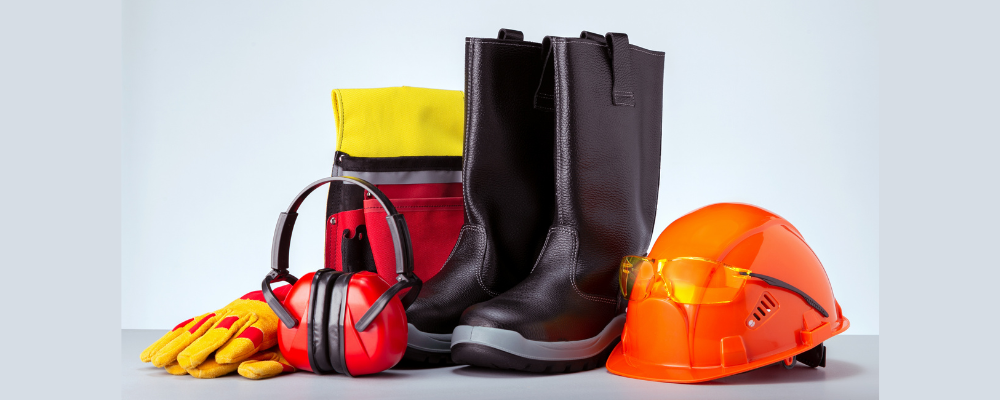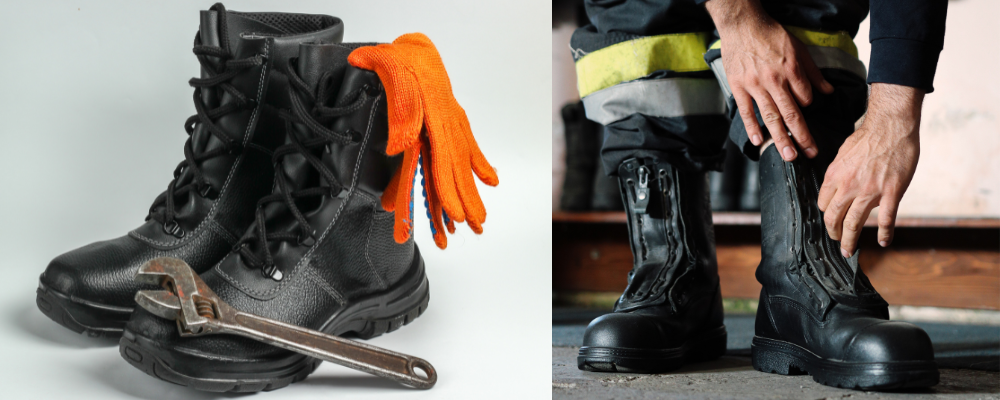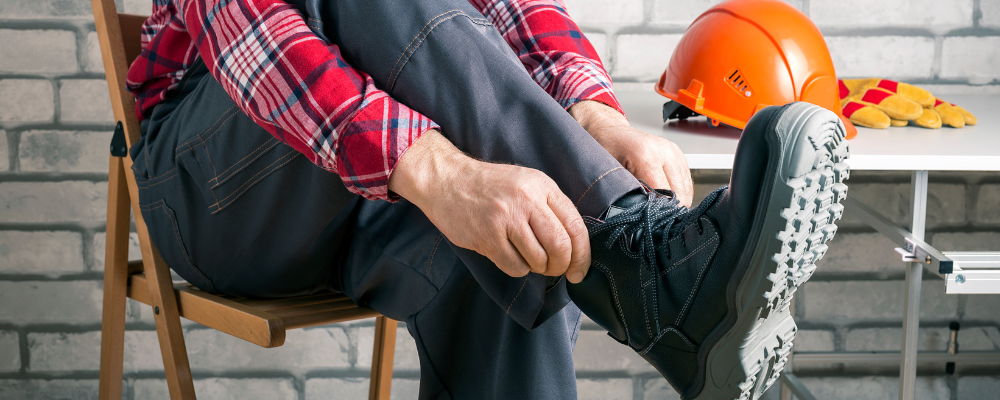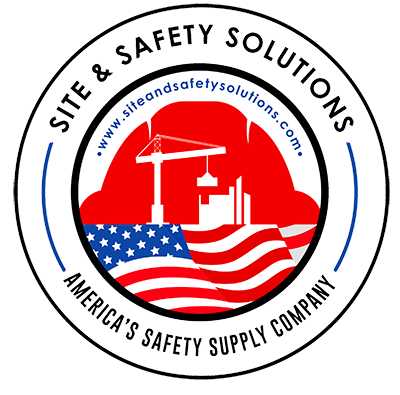
Introduction
Work Boots in construction sites are bustling hubs of productivity where every step taken holds the weight of safety, precision, and efficiency. Amidst the whirring machinery, towering structures, and the symphony of hammers, there stands an unsung hero – the work boot. More than a mere accessory, these sturdy companions form the bedrock of safety and productivity for every construction worker navigating the hazards of their workplace.
In the realm of construction, every day is a dance with danger. From navigating uneven terrain to braving slippery surfaces and enduring the constant risk of falling objects, the challenges faced by these workers are manifold. The statistics paint a stark picture: while vibrant and crucial to societal progress, the construction industry also holds the unfortunate distinction of being one of the most hazardous sectors for workplace injuries and accidents.
In this complex landscape of risks and responsibilities, the work boot emerges as a beacon of reliability, promising protection and empowerment. It’s the foundational element that ensures workers can confidently navigate their tasks, allowing them to focus on craftsmanship without compromising safety.
Understanding Work Boot Specifications
Key Features of High-Quality Work Boots
Work boots are indispensable tools for construction workers, offering many features designed to ensure safety, comfort, and durability in demanding work environments. Understanding the key attributes of high-quality work boots is vital for selecting the most suitable pair. Here are the critical features:
-
Toe Protection
Work boots often have reinforced toe caps, typically steel, composite materials, or alloy. These toe caps shield against impact and compression hazards, safeguarding the toes from heavy objects or accidental collisions.
-
Slip Resistance
The outsoles of quality work boots are engineered to provide exceptional traction on various surfaces. Incorporating specialized tread patterns and durable materials, these boots minimize the risk of slipping, especially on wet or uneven terrains commonly found on construction sites.
-
Waterproofing
Many work boots boast waterproofing technologies or materials that repel moisture, keeping the feet dry even in adverse weather conditions or when working in damp environments. This feature not only enhances comfort but also prevents potential foot issues associated with prolonged exposure to moisture.
-
Comfort
Comfort is paramount for workers spending long hours on their feet. Quality work boots feature cushioned insoles, ergonomic designs, and breathable materials that reduce fatigue and minimize strain on the feet, promoting productivity and overall well-being.

Product Spotlight: Protector Boot 43/10 S1P
The Protector Boot 43/10 S1P stands as a pinnacle of safety and reliability in the realm of work boots. Crafted meticulously to meet the stringent demands of construction environments, this boot excels in multiple facets.
Specifications:
- Toe Protection: Incorporates a robust steel toe cap meeting industry safety standards for impact resistance.
- Sole: Engineered with a puncture-resistant sole for added protection against sharp objects.
- Materials: Utilizes high-grade leather and composite materials for durability and flexibility.
- Certifications: Complies with S1P safety standards, ensuring protection against various workplace hazards.
Benefits:
- Enhanced Safety: The steel toe cap and puncture-resistant sole offer unparalleled protection against potential workplace hazards.
- Durability: Built with premium materials, the Protector Boot 43/10 S1P guarantees longevity even in rigorous working conditions.
- Comfort: Despite its robust build, the boot ensures comfort through ergonomic design and cushioned support, minimizing fatigue during extended wear.
Portwest Monsal Hiker Boots S3 WP HRO
The Portwest Monsal Hiker Boots S3 WP HRO embodies a fusion of innovation, comfort, and adaptability, making it an ideal choice for diverse construction environments.
Unique Selling Points:
- Waterproof and Breathable: The S3 WP feature ensures waterproofing while allowing breathability, preventing moisture buildup.
- Heat and Oil Resistance: The HRO designation signifies high resistance to heat and oil, crucial for construction settings with such hazards.
- Sole Construction: Incorporates a sturdy sole with enhanced grip and durability, suitable for various terrains.
Suitability for Construction Environments:
- Versatility: From rugged terrains to indoor projects, the Portwest Monsal Hiker Boots excel, offering reliable performance across diverse work settings.
- Safety Standards: Meets and exceeds safety certifications, ensuring protection against common construction hazards.
- These boots prioritize safety and durability and deliver comfort and adaptability, making them an indispensable asset for construction professionals seeking top-tier performance from their footwear.
Best Work Boots on the Market
Construction workers rely heavily on footwear for safety and comfort during demanding tasks. In this section, we’ll explore and evaluate one of the top-rated work boots for construction—the Men’s Thorogood 8″ Steel Toe Wedge Sole Work Boot—alongside other leading brands in the market.
Durability and Comfort: Thorogood 8″ Steel Toe Wedge Sole Work Boot
The Men’s Thorogood 8″ Steel Toe Wedge Sole Work Boot is a pinnacle in construction work footwear, renowned for its blend of durability, comfort, and safety features.
Construction and Materials:
Crafted using premium full-grain leather, this boot offers exceptional durability and resistance to abrasions commonly faced in construction environments. Its steel toe cap ensures protection against impact and compression hazards, meeting safety standards without compromising comfort.
Comfort Level:
Equipped with a removable cushioned insole, the Thorogood boot prioritizes comfort without sacrificing stability. The shock-absorbing wedge sole reduces fatigue during long hours on-site, making it an ideal choice for those seeking all-day support.
User Experiences:
Positive user feedback emphasizes the boot’s comfort during prolonged wear. Workers appreciate its superior traction on various surfaces, reducing the risk of slips and falls—a critical aspect in construction settings.
Comparative Analysis: Finding the Right Fit for Your Needs
To make an informed choice, comparing the Thorogood boot with other leading brands is crucial, considering various factors such as features, price points, and suitability for specific construction tasks.
Brand A – Protector Boot 43/10 S1P:
- Constructed with S1P safety specifications, this boot offers a lightweight design without compromising safety features.
- It’s equipped with a protective toecap and a slip-resistant sole, ensuring stability and protection in various construction environments.
- The price point of the Protector Boot 43/10 S1P makes it an affordable yet reliable choice for entry-level workers.
Brand B – Portwest Monsal Hiker Boots S3 WP HRO:
- Known for its waterproof and heat-resistant properties (S3 WP HRO), this boot is favored in environments with extreme conditions.
- The composite toe cap ensures safety while reducing weight compared to traditional steel-toe designs, enhancing agility.
- Though slightly pricier, its specialized features cater to specific construction tasks where waterproofing and heat resistance are critical.
Comparative Summary:
- Features: While the Thorogood boot excels in durability and comfort, Protector Boot 43/10 S1P and Portwest Monsal Hiker Boots prioritize lightweight design, affordability, waterproofing, and heat resistance.
- Price: Protector Boot 43/10 S1P stands out for its affordability, while Portwest Monsal Hiker Boots commands a slightly higher price for its specialized features.
- Suitability: Depending on the work environment and tasks, each boot presents unique advantages, catering to diverse needs within the construction industry.
- This comparative analysis aims to assist construction workers in selecting the most suitable work boots based on their specific requirements and preferences, emphasizing that different boots serve different purposes within the construction

Care and Maintenance of Work Boots
Prolonging the Lifespan of Your Work Boots
Regular care, maintenance, and proper storage are crucial to maximize the lifespan of your work boots. Here are essential tips to ensure their longevity:
- Cleaning: After each use, remove excess dirt and debris using a soft brush or damp cloth. For tougher stains, use a mild soap solution, but avoid harsh chemicals that could damage the materials.
- Drying: Never expose your boots to direct heat sources like radiators or open flames, as this can cause the materials to crack or shrink. Instead, air-dry them at room temperature, stuffing them with newspaper to absorb moisture.
- Conditioning: Apply a suitable conditioner or waterproofing treatment to protect the boots from water damage and maintain the integrity of the materials. Be sure to follow the manufacturer’s recommendations regarding the specific product.
- Inspection: Regularly inspect your boots for signs of wear and tear, such as loose stitching or worn-out soles. Promptly address any issues to prevent further damage and extend their lifespan.
Ensuring Optimal Performance: Care Instructions for Different Materials
Different work boot materials require specific care to maintain their performance and durability:
- Leather Boots: Use a leather conditioner or cream to keep the leather supple and prevent cracking. Additionally, use a leather protector to safeguard against water damage. Allow them to dry naturally and avoid prolonged exposure to sunlight.
- Composite Boots: Wipe composite materials with a damp cloth and mild soap. Avoid using harsh chemicals that could degrade the composite elements. Apply a protective coating to maintain their strength and durability.
- Steel-Toe Boots: Inspect steel components regularly for rust or corrosion. Clean with a damp cloth and dry thoroughly to prevent rust formation. Lubricate hinges and moving parts to ensure smooth functionality.
Visit our page for more products like
Portwest Monsal Hiker Boots S3 WP HRO
Men’s Thorogood 8″ Steel Toe Wedge Sole Work Boot (U.S.A.)
For more information, visit our website and Facebook page.
Conclusion
In the demanding environment of construction sites, the importance of reliable work boots cannot be overstated. Proper care and maintenance not only prolong the lifespan of these boots but also ensure they continue to provide the necessary protection and support for workers.
Prioritizing safety and comfort through investing in high-quality work boots is an investment in personal well-being and professional efficiency. By following the recommended care instructions and maintenance routines, construction workers can ensure their boots remain in optimal condition, offering the utmost protection and comfort throughout their usage.
Amid these challenges lies a paramount consideration: selecting appropriate work boots. These aren’t just footwear pieces; they are meticulously crafted shields designed to safeguard against many risks encountered on site. The right pair of work boots isn’t merely about comfort or style; it’s a strategic choice that can mean the difference between a safe, productive day and a potential injury.
For a wide selection of top-quality work boots explicitly designed for the challenges of construction work, explore our range at Site and Safety Solutions. Your safety matters to us, and we’re committed to providing the best footwear solutions for your needs. Visit our website or contact our team for more information on our products and how they can benefit you.









